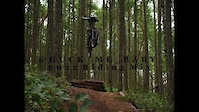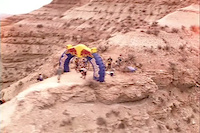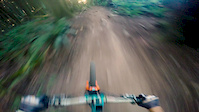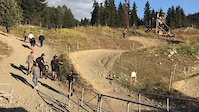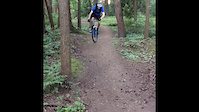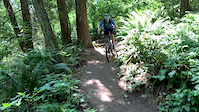Video player is disabled while the embed window is open.
Copy and paste the HTML code below:
Color:
Size: X
|
| |
Out trying to destroy my XC bike again.
Local trails, weeknight XC antics.
9 Comments
- + 1
Cool - pretty insightful stuff! I'm 6-4 so its interesting to see how some of the other top tall riders ride. I was lucky enough to do the Trans Cascadia 2 years ago when both Minnaar and Peat were there which was fun to see in person. I remember Gregs bike was funky, he had pretty flat bars but probably 50mm of spacers. I typically prefer a bit lower of a cockpit setup and to your point, there are not huge variations between some of the shorter women and taller guys. I also prefer a bit of an older school setup, while I have a new bike I opted to get one that was the least extreme and run it in the high position to steepen the head angle as much as is realistic....it's a Banshee Titan. I come from a XC racing background so prefer a bike to pedal well vs smashing over stuff and honestly would prefer the 'enduro geometry' from say 2018'ish.
- + 1
Speaking of XC, low bars, and old school setups, here’s my 1999 Litespeed in action: www.pinkbike.com/video/532712
Yes, Greg is someone I’d like to see with 1) a proper 50mm high-rise bar, and 2) a longer stem for his lengthy arms — I think it would solve a lot of his “puzzling” about setup and the bike-weighting/balance troubles he has mentioned. He’s currently constrained by the standard 35, 40, 50, 55 (and maybe 60mm) direct mount stems, plus his reach is shorter due to his super tall spacers. He could probably ride faster and better-balanced with 70mm or 75mm stem (considering all those spacers shortening the reach) on his DH bike, or maybe a 65mm stem with a higher rise bar that doesn’t have the spacers (not unlike Florent Payet’s stem at 62mm or maybe 65mm).
And yeah, I too like the rideability of bikes like a 2017 Bronson (probably comparable to a new 5010). Not too extreme and good wheel weighting for a moderately-agressive riding style and riding position for our typical popular PNW riding areas that aren’t too steep nor too extreme. Plus, they’re not too long, so they manual for days with little effort. I’ve only done a few full-360 manuals — one of which was my first try in a parking lot about 60 seconds after hopping on my buddy’s 2017 Bronson. I’m astonished at how lots of top-end new bikes up my level of riding and dynamic balance significantly (in various ways), as well as how much more dangerous the speed you can attain on aggressive new 29ers can be, ha! Lots of buddies have had the biggest crashes of their lives on new 29er All Mountain and Enduro bikes in the last few years. Many of those bikes are made for pro-level aggression and manhandling...but if you get massive rolling speed from the wheels and stability of these new platforms along with their amazing suspension, riders can get into a speed range that the handling inputs required are beyond their level of experience / strength / expertise / muscle memory / response time / visual-processing ability / steering & gyroscopic force-recognition ability (especially with 29” wheels at high speed) and so forth...and people crash hard. Many adjust and get used to it, but it’s kind of like riders hopping on a 250cc 2-stroke from an 80cc 2-stroke and going out and wrecking themselves...it can take several months to acclimate in some cases, ha! So yeah, I’m currently looking for a 2017/18 era Santa Cruz, Intense, Ancillotti, or maybe some cool polished aluminun bike like a new Commencal, some boutique brand, or maybe a custom Ancillotti Scarab Evo 29 or Evo mullet.
Yes, Greg is someone I’d like to see with 1) a proper 50mm high-rise bar, and 2) a longer stem for his lengthy arms — I think it would solve a lot of his “puzzling” about setup and the bike-weighting/balance troubles he has mentioned. He’s currently constrained by the standard 35, 40, 50, 55 (and maybe 60mm) direct mount stems, plus his reach is shorter due to his super tall spacers. He could probably ride faster and better-balanced with 70mm or 75mm stem (considering all those spacers shortening the reach) on his DH bike, or maybe a 65mm stem with a higher rise bar that doesn’t have the spacers (not unlike Florent Payet’s stem at 62mm or maybe 65mm).
And yeah, I too like the rideability of bikes like a 2017 Bronson (probably comparable to a new 5010). Not too extreme and good wheel weighting for a moderately-agressive riding style and riding position for our typical popular PNW riding areas that aren’t too steep nor too extreme. Plus, they’re not too long, so they manual for days with little effort. I’ve only done a few full-360 manuals — one of which was my first try in a parking lot about 60 seconds after hopping on my buddy’s 2017 Bronson. I’m astonished at how lots of top-end new bikes up my level of riding and dynamic balance significantly (in various ways), as well as how much more dangerous the speed you can attain on aggressive new 29ers can be, ha! Lots of buddies have had the biggest crashes of their lives on new 29er All Mountain and Enduro bikes in the last few years. Many of those bikes are made for pro-level aggression and manhandling...but if you get massive rolling speed from the wheels and stability of these new platforms along with their amazing suspension, riders can get into a speed range that the handling inputs required are beyond their level of experience / strength / expertise / muscle memory / response time / visual-processing ability / steering & gyroscopic force-recognition ability (especially with 29” wheels at high speed) and so forth...and people crash hard. Many adjust and get used to it, but it’s kind of like riders hopping on a 250cc 2-stroke from an 80cc 2-stroke and going out and wrecking themselves...it can take several months to acclimate in some cases, ha! So yeah, I’m currently looking for a 2017/18 era Santa Cruz, Intense, Ancillotti, or maybe some cool polished aluminun bike like a new Commencal, some boutique brand, or maybe a custom Ancillotti Scarab Evo 29 or Evo mullet.
- + 1
@WRCDH: good point about bikes getting easier to ride and getting folks in over their heads, I've noticed it myself too and I think any Friday Fails will drive that point home! There is very little feedback before they let loose whereas the older bikes are somewhat self limiting and you can feel them getting sketchy before they bite! I do a lot of dirtbiking too and generally think less is more - I typically ride 250 - 350F's as they are easier to ride, you don't get into trouble as fast and tend to be just as fast.
Take Sam Hill and put him on a bike from 2018, he still wins, with that said, he's another guy that has that older school style, a bit more upright, calm body....
Take Sam Hill and put him on a bike from 2018, he still wins, with that said, he's another guy that has that older school style, a bit more upright, calm body....
- + 2
Thx! Yeah, I’m 6’3” on a 2010-12 Pivot Mach 4 26er with 45” Wheelbase and 67 head angle — so to stay centered on the bike, it does look old school. If you watch Steve Peat ride trail bikes, or other tall dudes, it’s similar. But yeah, newer longer bikes with raked out forks allow taller riders to stay more centered between the wheels (primarily in terms of front wheel weighting) but be in an more aggressive riding position (with a much lower dropper too). But in general, I try to ride the most responsive and agile bikes for a given trail — and I’ve been riding these trails since 1992 =). I just don’t like being over-biked in general. I also don’t run a clutch on XC — as the clutch wears the pulleys, chain, ring, and cassette more as the suspension cycles and pulls on the chain...thus the racket, haha.
- + 2
Here’s another local XC spot. Same bike but more open, and different, trails: www.pinkbike.com/video/524791
- + 2
Here’s a 2017 Peaty video — likely 27.5, and around 47.5” wheelbase, 66 head angle, and 140mm travel — an enduro bike, compared to my XC bike. But you can see the similar position due to the long legs and arms, and the need to stand more centered over the bike with more vertical arms than today’s typical shorter-than-average top DH riders. Just like nearly all top motocross riders are 5’6” to 5’9”, 80% of the top-10 downhillers in 2019 were in the standard deviation below average height — with many more significantly shorter than average than significantly taller than average. It comes down to being centered on today’s 52” wheelbase bikes and the energy expended on staying centered (which allows optimal wheel weighting and thus traction...also enabling easer / more refined subtle changes in wheel weighting and traction due to reduced “polar moment of inertia” of shorter riders, as well as lower center of gravity). Tall riders compensate through position, technique, and a little extra exertion to mitigate the deficiencies of being tall and maintaining optimal wheel weighting and low center of gravity. Just look at how upright, centered, and relaxed Loic Bruni can stand relative to Greg Minnaar, Steve Peat, or Florent Payet. Although there are benefits to being tall on some tracks — in my opinion very technical and steep tracks where long arms and limbs can be used to pump terrain and/or handle the steeps by getting rearward to maintain optimal wheel weighting. www.vitalmtb.com/videos/features/Vital-RAW-Steve-Peat-Flat-Pedals-and-a-Trail-Bike-at-Wharncliffe-Woods,33467/sspomer,2
- + 2
Likewise, Minnaar talks about his height and front-to-rear wheel weighting challenges of being tall, at 6:18 to 6:35 — it’s a struggle for all of us above maybe 6’2”. But Greg seems to be quite well-centered on his trail bike in the video, maybe because of wide bars and modern XL or XXL sizing. But it’s clear he has extraordinary balance as well as core strength and refined muscle memory and fine movement control...a truly world class sportsman who has adapted well to newer, bigger bikes. But you can still see that unique tall-guy stance that looks sort of old school just because of his long legs that result in a more horizontal back than shorter riders (particularly when the bar height of modern bikes doesn’t vary nearly as much as a rider’s heigh, arm length, and leg length — just look at 5’4” pro downhiller women who have a 41.5” height bar and then 6’3” pro dudes who have a 43” height bar). His position looks a lot more like when riders ran tall seatposts / saddles in downhill way back when, than Loic Bruni’s upright and centered riding position. youtu.be/QtFhBH94Uqs
- + 2
Oh, and that wasn’t brake-induced rear wheel sliding/skidding...it’s a rear-steering technique as I alternate feet for left and right corners and do weight-bias rear drifting on flat corners and some banked or bermed corners — took 3 years to master. I weight the forward/inside foot a bit and it transfers just enough weight to the front wheel, and off the back wheel, to initiate a rear wheel drift with no brakes at all. Applying that pressure to the front/inside foot not only creates forces that favor pushing the rear wheel outward, but the pressure and weighting ensures the front end doesn’t wash by providing adequate and proportionally-biased weighting to the front wheel while shifting weight off the rear wheel and letting it slide to square-up the rear end (then transferring weight to the other/rear foot, and thus rear wheel, to stop the slide).
I don’t know anyone else who has learned to alternate feet like me, but it works amazingly well and eliminates the differing weight biases inherent in single-foot-forward cornering. In my case, my front / inside foot is about parallel with the down tube — right foot forward & up on right corners, left foot forward & up on left corners. Here’s an example of it on a right corner in Hawaii: www.pinkbike.com/video/529689
I don’t know anyone else who has learned to alternate feet like me, but it works amazingly well and eliminates the differing weight biases inherent in single-foot-forward cornering. In my case, my front / inside foot is about parallel with the down tube — right foot forward & up on right corners, left foot forward & up on left corners. Here’s an example of it on a right corner in Hawaii: www.pinkbike.com/video/529689



